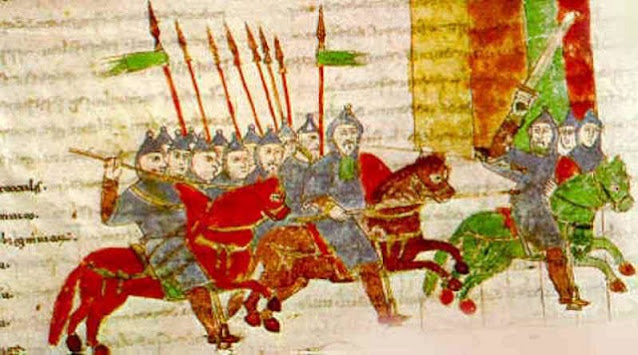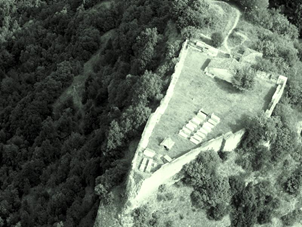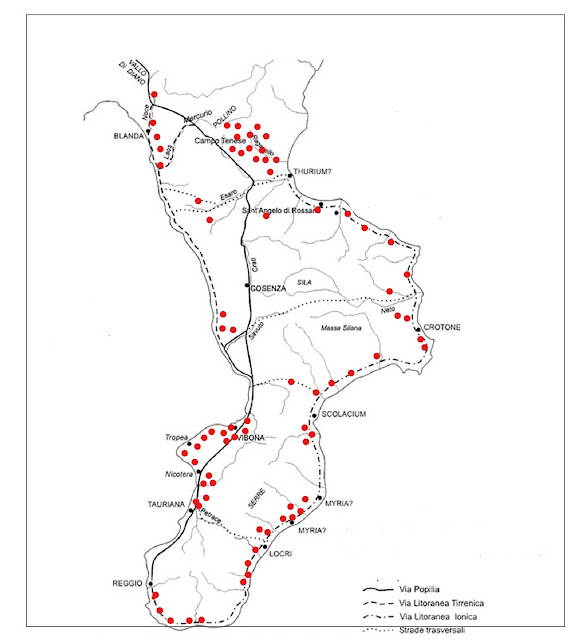LONGOBARDS IN CALABRIA
Invasion of Barbarians....
ORIGINS - The Lombards were a branch of the germanic people coming from Poland, subsequently arrived in Pannonia (current Hungary) in the V century a.C. and finally they entered in Italy in the middle of the VI century a.C..
In Italy occupied important ancient roman cities, among these Foro Giulio (Cividale), Aquileia, Verona, Brescia, Milano, Ivrea, etc. and since VII century a.C. establish their capital in Pavia (Longobardia Maior).
Note: EACH CITY WAS RULED BY A DUKE, WHO EXERCISED FUNCTIONS ADMINISTRATIVE AND EXECUTIVE, AND WAS A LITTLE AUTONOMOUS KINGDOM.
HISTORY IN ITALY: After several clashes with the Byzantines in the first half of the VII century a.C. conquered many italian territory.
After having subjected the Po Valley they crossed the Appenines reaching in Spoleto (important city in center Italy) electing it as a Duchy.
Their conquests continued in southern Italy, and in 576 a.C. chose Benevento as the capital of Longobardia minor (fig.1).
fig.1 - Lombard Italy - in green longobard territory and in yellow byzantine territory.
IN CALABRIA - They entered in Calabria at the end VI a.C. century along roman road Via Annia-Popilia, devastated the important ancient city of Taureanum and then arrived to Reggio Calabria. Then they gradually withdraw to the north of the Region positioning the territorial limit at the level of the Savuto river and Crati's valley (near Cosenza).
For almost three centuries (early VII - end IX A.C.) of domination the Lombards exploit resources, leaving widespread poverty.
For almost three centuries (early VII - end IX A.C.) of domination the Lombards exploit resources, leaving widespread poverty.
The benedictine monk and longobard historian Paolo Diacono (720-799 A.C)., in his work Historia Longobardorum narrates that the King Autari reached up to Reggio Calabria (late VI century a.C.) and touched with his lance an ancient columna few meters from the shore and said:"my kingdom arrivals here".
With them the whole clergy of the ancient Thurium fled, and there was no priest to administer the sacraments, so at the beginning of the VII century (maybe even earlier) the bishop took refuge in byzantine Rossano.
fig.2 - map of roman road Annia-Popilia (in blu) and point in red the ancient port city of Taureanum, it was an episcopal see and with the lombard raid the bishop and all clergy took refuge in Sicily.
In an epistle (591 a.C.) of Pope Gregory so-called Magno narrates this fact: "Vir venerabilis Paulinus episcupus Tauri civitas provinciae Brittiorum, nobis asseruit, monachos suos occasione dispersos barbarica usque nunc per totam vagare Siciliam".
In an epistle (591 a.C.) of Pope Gregory so-called Magno narrates this fact: "Vir venerabilis Paulinus episcupus Tauri civitas provinciae Brittiorum, nobis asseruit, monachos suos occasione dispersos barbarica usque nunc per totam vagare Siciliam".
route followed by the Longobards through the Roman way Via Popilia:
in blu Via Popilia, in red the position ancient city of Taureanum, in green itinerary of escape of the bishop through roman harbour to Sicily and in pink Reggio Calabria.
ruins of Taureanum and in the foreground stretch of the Via Popilia
With them the whole clergy of the ancient Thurium fled, and there was no priest to administer the sacraments, so at the beginning of the VII century (maybe even earlier) the bishop took refuge in byzantine Rossano.
In Calabria the Lombards chose to settle in some cities built on high-ground useful for controlling strategic passages, these were Laino, Cassano, Malvito and Cosenza, were the military centers and of the administration, where the lombards high official resided, these urban settlements were so-called "gastaldati" (fig.3).
In these cities since VII to the IX century A.C. the high official made military, legal and economic decisions on behalf of the Duchy of Benevento.
fig.3 - in red longobards gastaldati in Calabria
Note: The new lombard centers (shown in the map above) were chosen because located on internal communication lines, avoiding the coastal areas, becouse the Lombard were not skilled navigators and did not have a naval fleet.

Laino - at the top there is the longobard fortress (called Laino Castello)
medieval town of Malvito
MALVITO - Longobard-Norman castle
COSENZA - elected as most important "gastaldato" in Calabria, for the control of inland roads bordering the byzantine territory, near to limes.
Calabria in the VIII century a.D., punctuated in blu limes: the white part is longobard territory and in grey is the byzantine territory
NOTE - The boundiaries of the two Duchies in nearly three centuries (VII-IX a.D.) were always changing, nowadays scholars have no sure data.
In the north of Calabria, precisely in the municipality of Aieta we also find an important roader structure, that is a lombard bridge dated to VII century a.D..
lombard bridge (VII-VIII century a.C.)
(foto from lorizzonte.net)
Longobard necropolis - Castrovillari in north Calabria
CURIOSITY: In 599 a.C. the Pope Gregory Magno (540-604 a.C.) agreed with the Lombard Duke of Benevento to pass the wooden beams of the Sila forest through his territories, useful for building the roofs of the churches and basilicas of Rome.
SILA
in yellow National Park of the Sila
CONCLUSIONS: After the defeat of Desiderio the last king of the longobards in 774 A.C., the kingdom of northen Italy (Langobardia maior) with capital Pavia was annexed to the Empire of Charle Magne.
Instead the duchy of Benevento (Longobardia minor) and then of Salerno continued to live by becoming an autonomous kingdom until arrival of the Normans (1034-1040 A.C.).
SEE YOU SOON!!!!!!!!💜
Instead the duchy of Benevento (Longobardia minor) and then of Salerno continued to live by becoming an autonomous kingdom until arrival of the Normans (1034-1040 A.C.).
Langobardia Minor in the IX century a.C.
SEE YOU SOON!!!!!!!!💜
Dott. Giuseppe Lombardo























Commenti
Posta un commento